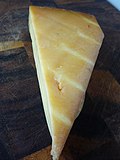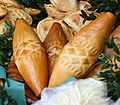Smoked cheese
Smoked cheese is a variety of cheese that has been specially treated by smoke-curing. It is a process that can take from a few hours to several days, depending on the desired result. The procedure involves exposing the cheese to smoke from burning or smoldering wood materials.
History[edit]
The tradition of smoke-curing cheese likely dates back to ancient times when people used smoke to preserve all kinds of perishable food items. The process not only helps to extend the shelf life of the cheese but also imparts a distinctive smoky flavor that many people find appealing.
Types of Smoked Cheese[edit]
There are many types of smoked cheese available, each with its unique flavor profile. Some of the most popular include:
- Gouda: This Dutch cheese is often smoked to enhance its naturally mild and creamy flavor.
- Cheddar: Smoked cheddar is a popular choice for its robust flavor and smooth texture.
- Mozzarella: When smoked, this Italian cheese takes on a whole new dimension of flavor.
- Provolone: This Italian cheese is often smoked to give it a more complex flavor profile.
Smoking Process[edit]
The smoking process can be done in several ways. Cold smoking is a method where the cheese is kept in a temperature-controlled environment away from the heat source. This allows the smoke to permeate the cheese without melting it. Hot smoking, on the other hand, exposes the cheese directly to the heat source, which can alter its texture and flavor.
Health Considerations[edit]
While smoked cheese can be a delicious addition to many dishes, it's important to note that the smoking process can also introduce potentially harmful substances into the cheese. These can include polycyclic aromatic hydrocarbons (PAHs), which have been linked to various health problems, including cancer. Therefore, it's recommended to consume smoked cheese in moderation.
See Also[edit]
Ad. Transform your life with W8MD's Budget GLP-1 injections from $75


W8MD offers a medical weight loss program to lose weight in Philadelphia. Our physician-supervised medical weight loss provides:
- Weight loss injections in NYC (generic and brand names):
- Zepbound / Mounjaro, Wegovy / Ozempic, Saxenda
- Most insurances accepted or discounted self-pay rates. We will obtain insurance prior authorizations if needed.
- Generic GLP1 weight loss injections from $75 for the starting dose.
- Also offer prescription weight loss medications including Phentermine, Qsymia, Diethylpropion, Contrave etc.
NYC weight loss doctor appointmentsNYC weight loss doctor appointments
Start your NYC weight loss journey today at our NYC medical weight loss and Philadelphia medical weight loss clinics.
- Call 718-946-5500 to lose weight in NYC or for medical weight loss in Philadelphia 215-676-2334.
- Tags:NYC medical weight loss, Philadelphia lose weight Zepbound NYC, Budget GLP1 weight loss injections, Wegovy Philadelphia, Wegovy NYC, Philadelphia medical weight loss, Brookly weight loss and Wegovy NYC
|
WikiMD's Wellness Encyclopedia |
| Let Food Be Thy Medicine Medicine Thy Food - Hippocrates |
Medical Disclaimer: WikiMD is not a substitute for professional medical advice. The information on WikiMD is provided as an information resource only, may be incorrect, outdated or misleading, and is not to be used or relied on for any diagnostic or treatment purposes. Please consult your health care provider before making any healthcare decisions or for guidance about a specific medical condition. WikiMD expressly disclaims responsibility, and shall have no liability, for any damages, loss, injury, or liability whatsoever suffered as a result of your reliance on the information contained in this site. By visiting this site you agree to the foregoing terms and conditions, which may from time to time be changed or supplemented by WikiMD. If you do not agree to the foregoing terms and conditions, you should not enter or use this site. See full disclaimer.
Credits:Most images are courtesy of Wikimedia commons, and templates, categories Wikipedia, licensed under CC BY SA or similar.
Translate this page: - East Asian
中文,
日本,
한국어,
South Asian
हिन्दी,
தமிழ்,
తెలుగు,
Urdu,
ಕನ್ನಡ,
Southeast Asian
Indonesian,
Vietnamese,
Thai,
မြန်မာဘာသာ,
বাংলা
European
español,
Deutsch,
français,
Greek,
português do Brasil,
polski,
română,
русский,
Nederlands,
norsk,
svenska,
suomi,
Italian
Middle Eastern & African
عربى,
Turkish,
Persian,
Hebrew,
Afrikaans,
isiZulu,
Kiswahili,
Other
Bulgarian,
Hungarian,
Czech,
Swedish,
മലയാളം,
मराठी,
ਪੰਜਾਬੀ,
ગુજરાતી,
Portuguese,
Ukrainian









